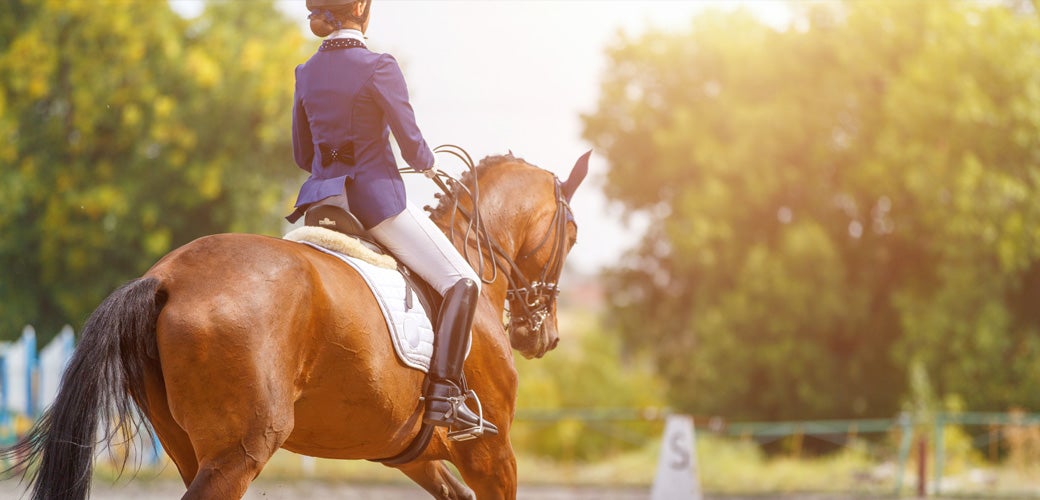
A Viewer’s Guide to the Olympic Equestrian Disciplines

The Olympics Games are in full swing, and if you’re an animal lover, one event on the schedule likely stands out—equestrian! Equestrian is one of the oldest disciplines of the Olympic Games, dating back to the ancient games that started in 776 B.C. The three equestrian disciplines certainly look different now, but the sport continues to test the skill and teamwork between horse and rider.
To communicate with a horse, riders must stay perfectly balanced and use very subtle shifts in weight and tighten specific muscles. Consequently, experience is as much a factor as any other physical skill and most riders will spend upwards of 10 hours a day in the saddle (on multiple horses) to condition and prepare for Olympic-caliber events.
During the Olympic Games, you’ll see three different equestrian sports. Riders rarely, if ever, cross between disciplines at this level due to the extreme specialization and skill needed to compete. Each discipline is carefully regulated with numerous safety protocols in place to ensure the wellbeing of the equine athletes. They are meticulously cared for and closely monitored to ensure they are healthy and well-rested
Dressage
Perhaps one of the most well-known Olympic equestrian events is dressage. Dressage is steeped in centuries of classical training and the sport is often considered to be the “highest expression of horse training.” The horse and rider must be in perfect harmony to complete a pre-determined series of movements requiring immense strength, precision and communication. Dressage is sometimes referred to as horse dancing by the lay person due to the beauty and elegance of movements like the canter pirouette and piaffe.
During the Olympics, the riders will compete for both team and individual medals over multiple rounds. During the exciting final “freestyle” round for individuals, the top riders will choreograph the order of movements to music to best show off their horse’s strengths and style.
What to look for: Each individual maneuver is scored between 0 and 10, and a total score is given after each test in the form of a percentage. For most riders, a score of a 65% percent or better would be considered very good. However, this is the Olympic Games, and the scores will be much higher. The average scores in the last two Olympic Games have trended upwards of 70-80%. The top finishers in the individual medals in Tokyo had spectacular scores in the high eighties with the gold medal winner scoring an impressive 91.732%. Keep an eye out for the recaps of their rides.
Interested in trying dressage? Meet adoptable horses who show potential for this discipline.
Show Jumping
The show jumping event takes place over five rounds, over varying courses of jumps set at 1.60M (approximately 5’3” tall). The first three rounds are used to determine the team medals, and the fourth and fifth rounds determine the individual titles. The riders use precision to help their equine partners arrive at the correct takeoff spot and in perfect balance to each fence. Many spectators find show jumping fun and exciting to watch, and it’s easy to follow the scoring, as an event of speed and accuracy.
What to look for: Fast and clear is the neigh-m of this game! The primary objective is to jump all the obstacles without knocking any rails down or touching the water over the water jump; if a rail hits the ground, the rider accrues four faults. The secondary objective is speed. Each round has a maximum time allowed. If that time is exceeded, the pair will begin accruing time faults that are scored similarly to rails coming down. The team with the lowest number of faults wins. In the event of a tie based on faults, the speediest pair wins.
Interested in trying jumping? Meet adoptable horses who show potential for this discipline.
Eventing
Eventing is a unique three-part event that tests the rider’s and horse’s athleticism and training. The sport contains three phases: a dressage test, a show-jumping course and a phase called cross country. The dressage and show-jumping phases will be like those you’ll see in their dedicated disciplines, only with less complexity due to the demands of multiple phases. During cross country, the horses and riders will tackle a complex course of natural obstacles over outdoor terrain, rather than an arena. The courses are much longer than those you’ll see in the show-jumping phase.
What to look for: Due to the nature of the sport, the individual and team medals will run concurrently and each competitor completes each phase once (as opposed to dressage and show-jumping where they compete for medals over multiple rounds). Every competitor will complete the same three phases, and medals will be determined based on cumulative scores. Dressage will be the first phase, and, for the next 2 phases, the goal is to add as few jump and time penalties as possible to the dressage score. The lowest combined score–the fewest penalties–between the three disciplines is the winner.
Interested in trying eventing? Meet adoptable horses who show potential for this discipline.
This year’s equestrian Olympic events began on July 24 and continue throughout the Games. If you feel inspired to try your hand at horseback riding, there are many ways to get involved with horses in your community and we encourage you to meet the hundreds of adoptable horses looking to make your equestrian dreams come true.
